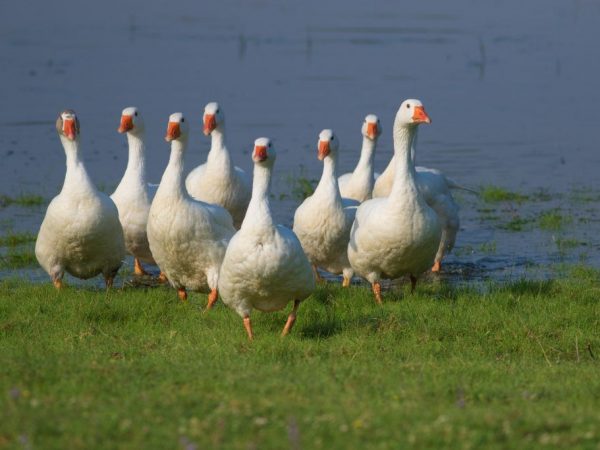Characteristics of Hungarian geese
Humanity has been breeding geese for many centuries, and, perhaps, this bird can be called one of the most popular among domesticated. Today, there are dozens of breeds in the world, many of which were bred as a result of selection. The article tells about such one as Hungarian geese.

Hungarian geese
Short description
Modern representatives of the Hungarian geese are the descendants of wild geese, which were crossed with the Emden and Pomeranians to preserve the species and improve the gene pool. These individuals were brought to Soviet countries shortly before perestroika. At home, in Hungary, the birds have a conservation status as the most actively bred in the country. The main producer of the breed is Bashkortostan.
The Hungarian goose is a large bird with a massive body, short legs, sloping back, protruding chest. The bill is usually orange, but almost always darkens with age. The male can be distinguished from the female by the length of the neck: in the gander it is usually longer and more muscular. Photos of Hungarian geese for clarity can be viewed on thematic sites.
Appearance and features
Gaining weight rather quickly, males reach a mass of up to 8 kg by maturity, and females - about 6 kg. The color is monochromatic, white or gray, spotted individuals are rarely found. Usually in the farms of our country you can see Hungarian white geese. What is remarkable about Hungarian geese among other species?
- Quality meat and delicious large liver (about 600 g).
- Valuable feather and down that can be plucked up to 4 times a year. It is interesting that there are special representatives of the species that are carriers of the frizzling gene, owners of the most valuable feather - the curling one. They can be distinguished by the softness of the plumage in the area of the thighs and tail.
- Fast weight gain: already at the age of 2 months, the goslings weigh 4.5 kg.
With proper care and abundant feeding, geese will be an excellent investment for a farmer in the farm and will pay off the costs of their maintenance. Like any breed, the Hungarian goose has its drawbacks, but they are not so significant. Here are some of the nuances that are quite surmountable if the recommendations of the experts are followed.
- poor tolerance to dampness, soreness;
- short lay period.
How to properly maintain a Hungarian goose and provide the necessary conditions to raise a good producer and get healthy offspring? Read about it below.
Maintenance and care
An active and mobile Hungarian goose should be driven into the house only in frosty weather. The flock spends most of the year in a specially equipped enclosure. A prerequisite is the presence of a nearby reservoir and a glade for walking. A spacious room is selected under the poultry house, where the birds will hide from the frost. The temperature in it may not exceed 0 ° C, but the floor must certainly be dry, and the litter is made of a material that feeds moisture - best if it is peat. We must not forget to regularly ventilate the room and carry out wet cleaning to prevent diseases in birds.
Provide pets with a trough for water cleansing treatments. It is advisable to fill the container with a mixture of sand and ash so that the birds can cleanse themselves of skin parasites. The issue of feeding the Hungarian goose requires special attention. Since poultry are raised for slaughter, their diet should not only be rich in quantity, but also balanced and contain all the vital minerals and nutrients.
Hungarian geese feed on grass in large doses: about 500 g per day, and they are quite picky and prefer nettles, dandelions, sour cherry, sorrel. Poultry farmers do not recommend swampy and weedy zones for grazing. In addition, the daily diet includes hay, root crops, grain crops and compound feed. The total daily intake of food received should be about 2 kg. Particular attention should be paid to the nutrition of the Hungarian goose in the winter, when it does not go out and does not have the opportunity to receive its own quota.
The peculiarity of the diet of a laying hen consists in a double dose of hay and nettle, but fattening in order to obtain the maximum liver size must be carried out in advance, from the age of two months and two weeks. In addition to crushed grain, chicks should receive protein feed. When the pet's weight reaches 6 kg, it is fed with boiled corn with the addition of sunflower oil and salt for about a month.
Reproduction control
The productive age of the Hungarian goose includes the period from 2 months from birth to 3 years. The productivity of a goose depends on the quality and quantity of food it consumes, and with adequate nutrition, it is capable of producing up to 55 eggs per year with a chick survival rate of about 70%. Each egg weighs an average of 175 g. Many owners prefer to use the services of an incubator to incubate their eggs.
Today, the popular Hungarian goose breed is in demand among large poultry farms and in narrow circles of amateur farmers. Eggs and young animals can be purchased at poultry stations and other large farms. There you can also get advice on the cultivation and breeding of such poultry as Hungarian geese. The description of these beauties speaks for itself: Hungarian pure-white geese are truly unique and profitable birds.


